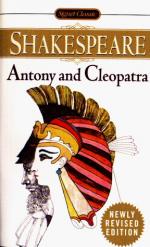|
This section contains 421 words (approx. 2 pages at 400 words per page) |

|
Antony and Cleopatra Summary & Study Guide Description
Antony and Cleopatra Summary & Study Guide includes comprehensive information and analysis to help you understand the book. This study guide contains the following sections:
This detailed literature summary also contains Further Study and a Free Quiz on Antony and Cleopatra by William Shakespeare.
Antony and Cleopatra was first listed for publication in 1608, but evidence strongly suggests that the play was Written and performed one or two years earlier No evidence exists to indicate that Antony and Cleopatra appeared in print before Its inclusion in the first Folio of 1623, therefore, the First Folio version of the play is considered by most critics to be authoritative.
Thomas North's "The Life of Antonio's" in his The Lives of the Nohle Grectanes and Romans compared together (1579)-an English translation of a work by Plutarch IS the principal source for Antony and Cleopatra. Scholars have remarked that Shakespeare followed North' translation of Plutarch closely for his play; they note in particular a close match between Shakespeare's poetic rendition of Enobarbus's description of Cleopatra on her barge and North's own prose translation of the episode critics, however, are divided on whether Shakespeare's characterizations of Antony and Cleopatra are more or less flattering than they are in North's translation of Plutarch.
Scholarly debate over Antony and Cleopatra has centered around Antony's "dotage" or decline and the relative nobleness of his character; Cleopatra's contradictory behavior and the significance of her death; the nature of the lovers' passion for one another; and the comparative wisdom or rashness of their actions Commentators have also examined Antony and Cleopatra's comparatively minor but nonetheless dramatically significant characters Octavius, Octavia, and Enobarbus Some scholars have focused on the connections between Shakespeare's Antony and Cleopatra and John Dryden's sixteenth-century version of the play, All for Love (1678). Other Issues of interest to critics include the play's language, Imagery, structure, and political context, as well as Its treatment of the mores and politics of a changing Rome versus those of Egypt. Thematic concerns include the relationship in the play between reason and imagination or passion, the nature of love, the choice between love and empire, and political or social disintegration. Recent scholarship has stressed the nature of the play's mytholog1cal and supernatural elements, the degree of sexism practiced by earlier Critics with regard to Cleopatra's character, and the relative merit of Antony and Cleopatra as a tragedy when ranked against such works as Hamlet, Othello, King Lear, and Macbeth The Irony and paradox that pervade Antony and Cleopatra and that render much of the play's action and many of Its themes problematic are of particular interest to critics today, and there appears to be a growing consensus that Shakespeare in fact intended that this drama of love, politics, ag1ng, and death be both ambivalent and ambiguous
Read more from the Study Guide
|
This section contains 421 words (approx. 2 pages at 400 words per page) |

|



